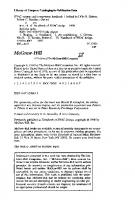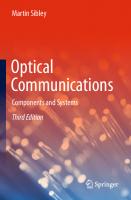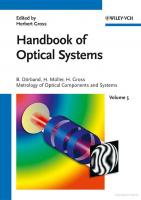Carbonate Platform Systems Components and Interactions 1862390746, 9781862390744, 9781423784463
Carbonate Platform Systems: components and interactions is a collection of 13 papers, plus an introduction, concerning t
254 96 930KB
English Pages 238 Year 2001
Table of contents :
Contents......Page 6
Carbonate platform systems: components and interactions – an introduction......Page 8
Fig. 1. Conceptual diagram illustrating the biological and sedimentological components and interactions .........Page 9
A temperate reef builder: an evaluation of the growth, morphology and composition of Sabellaria alveolata (L.) colonies on carbonate platforms in South Wales......Page 16
Fig. 1. Right ventral view of Sabellaria alveolata removed from its tube .........Page 17
Fig. 2. Photographs showing the extent, habitat and characteristics of S. alveolata .........Page 18
Fig. 3. United Kingdom map outlining the occurrence of S. alveolata and and detailing the study site.......Page 20
Fig. 4. Schematic diagram of sampling design, plot locations, biotopes and shore positions.......Page 22
Fig. 5. Frequency histogram plot showing the difference in particle size distribution .........Page 23
Skeletal growth rates of Upper Cretaceous rudist bivalves: implications for carbonate production and organism – environment feedbacks......Page 28
Fig. 2. Example of dense growth fabric of cylindrical shells of hippuritid .........Page 29
Fig. 3. Intra-shell variations in carbon and oxygen isotopic compositions (δ(sup[13])C, δ(sup[18])O), Mg .........Page 31
Fig. 4. Model of carbonate production by vertically growing shells of hippuritid .........Page 32
Fig. 5. Growth histories of rudists which shared the same (b) or closely .........Page 33
Fig. 6. Sketch of distribution of morphotypes and growth fabrics of Vaccinites .........Page 35
Table 1. Growth rates, individual and potential community production of CaCO3 (see text) .........Page 30
Spatial and temporal patterns of macroboring within Mesozoic and Cenozoic coral reef systems......Page 40
Fig. 1. Holocene: Discovery Bay, north Jamaica. Schematic diagram showing spatial (facies-related) .........Page 44
Fig. 2. Bar chart showing average macroboring community composition from sites where .........Page 45
Fig. 3. Boring traces from the Lias of Morocco (specimens of collection .........Page 47
Fig. 4. Boring traces (mouldic preservation) from the Oxfordian of Novion-Porcien, Dept. .........Page 48
Fig. 5. Upper Miocene: Cap Blanc-Cala Pi section, Mallorca. Schematic diagram showing .........Page 50
Fig. 6. Pleistocene: Falmouth Formation, north Jamaica. Schematic diagram showing spatial (facies-related) .........Page 51
Table 1. Macroborers and their borings in coral reef environments, along with simple .........Page 42
Table 2. Relative abundance of macroborers (by group) in reefs, compiled from studies with quantitative data......Page 43
Microfacies development in Late Archaean stromatolites and oolites of the Ghaap Group of South Africa......Page 58
Fig. 1. Locality map of the Ghaap Group, Cape Province, Republic of South Africa.......Page 59
Fig. 2. Simplified stratigraphic setting of the Ghaap Group, Cape Province, Republic of South Africa.......Page 60
Fig. 3. Thesauroid mat with conical supports from the Gamohaan Formation, (a) Cross-view .........Page 62
Fig. 4. Microbialites showing coiled microbial lamination rolled up in a carpet-like manner. .........Page 63
Fig. 5. Photomicrographs of matching couplets in plane polarized light (a, c) and under .........Page 65
Fig. 7. Contorted laminae encased in calcite under plane polarized light (a) and cathodoluminescence .........Page 66
Fig. 9. Dolomitized contorted laminae, sample WA93/31. Partially dolomitized lamina bundles under .........Page 67
Fig. 10. Micrographs of the thin section KI-2 from the Tsineng Member. .........Page 68
Fig. 11. X-ray diffractogram traces (45° 2θ) of bulk powdered .........Page 69
Fig. 13. Giant ooids, sample BK 7, in thin section under plane .........Page 70
Fig. 15. Sample BK 6 in thin section under plane polarized light .........Page 71
Fig. 16. Sample BK 7 in thin section under plane polarized light .........Page 72
Reefs and coral carpets in the northern Red Sea as models for organism – environment feedback in coral communities and its reflection in growth fabrics......Page 78
Fig. 1. Location map indicating the study area (Egyptian Red Sea) and names .........Page 80
Fig. 2. Definition of the terms 'reef' (A) and 'coral carpet' (B) as used .........Page 81
Fig. 3. Conceptual models illustrating several possibilities of coral reef and carpet .........Page 83
Fig. 4. Distribution of coral framework types in northern Safaga Bay, Red .........Page 84
Fig. 5. Illustration of framework types in the northern Red Sea. (A) .........Page 87
Fig. 6. Schematic representation of the distribution of northern Red Sea coral .........Page 88
Fig. 7. Schematic relationship between biological characteristics of coral communities and coral .........Page 91
Fig. 8. Suggested interactions between geological and biological processes in coral framework .........Page 92
Table 1. Ecological zonation (indicator species), average living coral cover values and growth .........Page 86
Fig. 1. Factors controlling the fabric of coralline algae dominated limestones.......Page 96
Fig. 2. Study area with lithologies and location of profiles (KO = Korenovec see Fig. 3)......Page 100
Fig. 3. Profile (locality Korenovec) with modal analysis of biogenic components as .........Page 102
Fig. 4. Growth forms of coralline algae in the Lower Oligocene Gornji Grad Beds.......Page 104
Fig. 5. Taphonomic features of coralline algae in the Lower Oligocene Gornji Grad Beds.......Page 106
Fig. 6. Schematic representation of the three coralline algae dominated facies within .........Page 108
Fig. 7. (a) Thick crust of Neogoniolithon in the coralline algal facies showing .........Page 110
Table 1. Coralline algal taxonomy and growth forms of the Lower Oligocene Gornji Grad Beds......Page 101
Table 2. Comparison of facies, coralline algal taxonomy, growth forms and taphonomy .........Page 103
Factors regulating the development of elevator rudist congregations......Page 116
Fig. 1. Ascending series of cross-sections (arranged down page, with basal section .........Page 118
Fig. 2. Ascending series of cross-sections (arranged down page, with basal section .........Page 119
Fig. 3. Model for maintaining the numerical density of a hippuritid congregation .........Page 121
Table 1. Recruitment and change of numerical density of hippuritids from les Collades de Basturs......Page 117
El Niño-Southern Oscillation mass mortalities of reef corals: a model of high temperature marine extinctions?......Page 124
Fig. 1. Worldwide distribution of coral reef bleaching events 1996–1998. Only strong .........Page 129
Fig. 2. Gardineroseris planulata (Dana) with lobes formed from tissue surviving the 1982/83 .........Page 133
Fig. 3. Longitudinal sections of 5 cm diameter cores drilled through the lobes .........Page 134
Table 1. Observed immediate and long-term ENSO disturbances affecting reef-building corals and coral reef structures......Page 126
Isolated carbonate platforms of Belize, Central America: sedimentary facies, late Quaternary history and controlling factors......Page 142
Fig. 1. Geological–tectonic setting of isolated carbonate platforms of Belize (after Dillon & Vedder .........Page 143
Fig. 2. Description of deep boreholes on Turneffe Islands and Glovers Reef .........Page 144
Fig. 3. Maps of isolated carbonate platforms offshore from Belize. Water depth .........Page 145
Fig. 4. Sedimentary facies of isolated carbonate platforms (after Gischler 1994; Gischler .........Page 146
Fig. 5. Description of rotary cores on Lighthouse Reef (core hole numbers .........Page 148
Fig. 6. Cross-sections through isolated carbonate platforms based on rotary core drilling, .........Page 149
Table 2. Radiometric dates from rotary cores through isolated platforms offshore from Belize......Page 150
Fig. 8. Wave-sheltered positions of Turneffe Islands due to position of Lighthouse .........Page 151
Table 1. Radiometric ages of sediment samples from Glovers Reef......Page 147
Reef episodes, anoxia and sea-level changes in the Frasnian of the southern Timan (NE Russian platform)......Page 154
Fig. 1. (A) Map of the northeastern part of European Russia showing the Timan .........Page 155
Fig. 2. Diagram showing the main geological structural zones in the Timan and Pechora Basin.......Page 157
Fig. 3. Map showing the position of boreholes in the Ukhta and Tebuk–Viss .........Page 158
Fig. 4. Two geological cross-sections showing the structure of the Frasnian bioherms, .........Page 159
Fig. 5. Diagram illustrating the stratigraphic terminology and biostratigraphic divisions of the late .........Page 161
Fig. 6. Diagram illustrating the development of the Frasnian reef complexes of .........Page 163
Fig. 7. Table showing the relation of the Timan–Pechora regional stage .........Page 167
Fig. 8. Diagrams illustrating the section of the uppermost Ust'yarega Formation and early .........Page 170
Fig. 9. Diagram illustrating the sequence of ammonoid faunas in the southern .........Page 171
Fig. 10. Sequence stratigraphic interpretation of the reef development in the Frasnian .........Page 173
Fig. 11. Interpretation of sea-level changes in the southern Timan–Pechora Basin through .........Page 174
Fig. 12. Comparison of the sea-level curves deduced for the Frasnian of the Southern .........Page 176
Rudist lithosome development on the Maiella Carbonate Platform margin......Page 184
Fig. 1. Simplified geological map of central Italy and Upper Cretaceous facies .........Page 185
Fig. 2. Schematic cross-section of the Maiella platform margin; modified from Eberli .........Page 186
Fig. 4. Percentage distribution of lithologies in relation to total stratigraphic thickness .........Page 187
Fig. 5. Characterization of the lithosome types defined in the Maiella platform .........Page 188
Fig. 6. Caprinid lithosome (lithosome type A). Large and complete specimens of .........Page 189
Fig. 8. Detailed logs of type C lithosomes. In each section, there .........Page 190
Fig. 9. Close-up of a hippuritid cluster. There is very little space .........Page 191
Fig. 10. Distefanella layers in a succession of bioclastic grainstones to rudstones. .........Page 192
Fig. 13. Detail of a type I lithosome. Note the grainstone to floatstone .........Page 193
Fig. 14. Abundance of the various lithosome types along the Maiella platform margin.......Page 194
Fluctuations in the carbonate production of Phanerozoic reefs......Page 198
Fig. 1. Field examples of reef carbonate production and debris potential. (a) .........Page 201
Table 2. Transformation of interval classes in the database to metric values......Page 202
Fig. 3. Secular variations in the main determinants of Phanerozoic reefal carbonate .........Page 203
Fig. 4. Cumulative reefal carbonate production in supersequences as calculated from the database. .........Page 204
Fig. 5. Phanerozoic reefal carbonate production rates. P(sub[n])/Ma = total net carbonate production .........Page 205
Fig. 6. Measured area of shallow-water carbonate areas (excluding chalk) through time .........Page 212
Fig. 7. Comparison of reefal carbonate export with the size of carbonate .........Page 213
Fig. 8. Palaeogeographic map of the Late Ordovician supersequence as an example .........Page 215
Fig. 9. Palaeogeographic map of the Late Triassic supersequence as an example .........Page 217
Table 1. Definition of supersequences as used in this paper......Page 200
Table 3. Simplified correlation matrix of the determinants of export production with other fields in the database......Page 207
Table 4. Simplified correlation matrix of the determinants of export production with Earth system parameters......Page 210
Sedimentation rates and growth potential of tropical, cool-water and mud-mound carbonate systems......Page 224
Fig. 1. The chemical modes of marine carbonate precipitation – a cascade of options. .........Page 225
Fig. 2. Carbonate factories. Viewed at the scale of formations or environnmental .........Page 226
Fig. 3. Sedimentation rates of the three carbonate factories plotted against the length .........Page 227
Fig. 4. Data of Fig. 3 plotted as thickness versus time. If sedimentation .........Page 229
E......Page 236
O......Page 237
Z......Page 238
Contents......Page 6
Carbonate platform systems: components and interactions – an introduction......Page 8
Fig. 1. Conceptual diagram illustrating the biological and sedimentological components and interactions .........Page 9
A temperate reef builder: an evaluation of the growth, morphology and composition of Sabellaria alveolata (L.) colonies on carbonate platforms in South Wales......Page 16
Fig. 1. Right ventral view of Sabellaria alveolata removed from its tube .........Page 17
Fig. 2. Photographs showing the extent, habitat and characteristics of S. alveolata .........Page 18
Fig. 3. United Kingdom map outlining the occurrence of S. alveolata and and detailing the study site.......Page 20
Fig. 4. Schematic diagram of sampling design, plot locations, biotopes and shore positions.......Page 22
Fig. 5. Frequency histogram plot showing the difference in particle size distribution .........Page 23
Skeletal growth rates of Upper Cretaceous rudist bivalves: implications for carbonate production and organism – environment feedbacks......Page 28
Fig. 2. Example of dense growth fabric of cylindrical shells of hippuritid .........Page 29
Fig. 3. Intra-shell variations in carbon and oxygen isotopic compositions (δ(sup[13])C, δ(sup[18])O), Mg .........Page 31
Fig. 4. Model of carbonate production by vertically growing shells of hippuritid .........Page 32
Fig. 5. Growth histories of rudists which shared the same (b) or closely .........Page 33
Fig. 6. Sketch of distribution of morphotypes and growth fabrics of Vaccinites .........Page 35
Table 1. Growth rates, individual and potential community production of CaCO3 (see text) .........Page 30
Spatial and temporal patterns of macroboring within Mesozoic and Cenozoic coral reef systems......Page 40
Fig. 1. Holocene: Discovery Bay, north Jamaica. Schematic diagram showing spatial (facies-related) .........Page 44
Fig. 2. Bar chart showing average macroboring community composition from sites where .........Page 45
Fig. 3. Boring traces from the Lias of Morocco (specimens of collection .........Page 47
Fig. 4. Boring traces (mouldic preservation) from the Oxfordian of Novion-Porcien, Dept. .........Page 48
Fig. 5. Upper Miocene: Cap Blanc-Cala Pi section, Mallorca. Schematic diagram showing .........Page 50
Fig. 6. Pleistocene: Falmouth Formation, north Jamaica. Schematic diagram showing spatial (facies-related) .........Page 51
Table 1. Macroborers and their borings in coral reef environments, along with simple .........Page 42
Table 2. Relative abundance of macroborers (by group) in reefs, compiled from studies with quantitative data......Page 43
Microfacies development in Late Archaean stromatolites and oolites of the Ghaap Group of South Africa......Page 58
Fig. 1. Locality map of the Ghaap Group, Cape Province, Republic of South Africa.......Page 59
Fig. 2. Simplified stratigraphic setting of the Ghaap Group, Cape Province, Republic of South Africa.......Page 60
Fig. 3. Thesauroid mat with conical supports from the Gamohaan Formation, (a) Cross-view .........Page 62
Fig. 4. Microbialites showing coiled microbial lamination rolled up in a carpet-like manner. .........Page 63
Fig. 5. Photomicrographs of matching couplets in plane polarized light (a, c) and under .........Page 65
Fig. 7. Contorted laminae encased in calcite under plane polarized light (a) and cathodoluminescence .........Page 66
Fig. 9. Dolomitized contorted laminae, sample WA93/31. Partially dolomitized lamina bundles under .........Page 67
Fig. 10. Micrographs of the thin section KI-2 from the Tsineng Member. .........Page 68
Fig. 11. X-ray diffractogram traces (45° 2θ) of bulk powdered .........Page 69
Fig. 13. Giant ooids, sample BK 7, in thin section under plane .........Page 70
Fig. 15. Sample BK 6 in thin section under plane polarized light .........Page 71
Fig. 16. Sample BK 7 in thin section under plane polarized light .........Page 72
Reefs and coral carpets in the northern Red Sea as models for organism – environment feedback in coral communities and its reflection in growth fabrics......Page 78
Fig. 1. Location map indicating the study area (Egyptian Red Sea) and names .........Page 80
Fig. 2. Definition of the terms 'reef' (A) and 'coral carpet' (B) as used .........Page 81
Fig. 3. Conceptual models illustrating several possibilities of coral reef and carpet .........Page 83
Fig. 4. Distribution of coral framework types in northern Safaga Bay, Red .........Page 84
Fig. 5. Illustration of framework types in the northern Red Sea. (A) .........Page 87
Fig. 6. Schematic representation of the distribution of northern Red Sea coral .........Page 88
Fig. 7. Schematic relationship between biological characteristics of coral communities and coral .........Page 91
Fig. 8. Suggested interactions between geological and biological processes in coral framework .........Page 92
Table 1. Ecological zonation (indicator species), average living coral cover values and growth .........Page 86
Fig. 1. Factors controlling the fabric of coralline algae dominated limestones.......Page 96
Fig. 2. Study area with lithologies and location of profiles (KO = Korenovec see Fig. 3)......Page 100
Fig. 3. Profile (locality Korenovec) with modal analysis of biogenic components as .........Page 102
Fig. 4. Growth forms of coralline algae in the Lower Oligocene Gornji Grad Beds.......Page 104
Fig. 5. Taphonomic features of coralline algae in the Lower Oligocene Gornji Grad Beds.......Page 106
Fig. 6. Schematic representation of the three coralline algae dominated facies within .........Page 108
Fig. 7. (a) Thick crust of Neogoniolithon in the coralline algal facies showing .........Page 110
Table 1. Coralline algal taxonomy and growth forms of the Lower Oligocene Gornji Grad Beds......Page 101
Table 2. Comparison of facies, coralline algal taxonomy, growth forms and taphonomy .........Page 103
Factors regulating the development of elevator rudist congregations......Page 116
Fig. 1. Ascending series of cross-sections (arranged down page, with basal section .........Page 118
Fig. 2. Ascending series of cross-sections (arranged down page, with basal section .........Page 119
Fig. 3. Model for maintaining the numerical density of a hippuritid congregation .........Page 121
Table 1. Recruitment and change of numerical density of hippuritids from les Collades de Basturs......Page 117
El Niño-Southern Oscillation mass mortalities of reef corals: a model of high temperature marine extinctions?......Page 124
Fig. 1. Worldwide distribution of coral reef bleaching events 1996–1998. Only strong .........Page 129
Fig. 2. Gardineroseris planulata (Dana) with lobes formed from tissue surviving the 1982/83 .........Page 133
Fig. 3. Longitudinal sections of 5 cm diameter cores drilled through the lobes .........Page 134
Table 1. Observed immediate and long-term ENSO disturbances affecting reef-building corals and coral reef structures......Page 126
Isolated carbonate platforms of Belize, Central America: sedimentary facies, late Quaternary history and controlling factors......Page 142
Fig. 1. Geological–tectonic setting of isolated carbonate platforms of Belize (after Dillon & Vedder .........Page 143
Fig. 2. Description of deep boreholes on Turneffe Islands and Glovers Reef .........Page 144
Fig. 3. Maps of isolated carbonate platforms offshore from Belize. Water depth .........Page 145
Fig. 4. Sedimentary facies of isolated carbonate platforms (after Gischler 1994; Gischler .........Page 146
Fig. 5. Description of rotary cores on Lighthouse Reef (core hole numbers .........Page 148
Fig. 6. Cross-sections through isolated carbonate platforms based on rotary core drilling, .........Page 149
Table 2. Radiometric dates from rotary cores through isolated platforms offshore from Belize......Page 150
Fig. 8. Wave-sheltered positions of Turneffe Islands due to position of Lighthouse .........Page 151
Table 1. Radiometric ages of sediment samples from Glovers Reef......Page 147
Reef episodes, anoxia and sea-level changes in the Frasnian of the southern Timan (NE Russian platform)......Page 154
Fig. 1. (A) Map of the northeastern part of European Russia showing the Timan .........Page 155
Fig. 2. Diagram showing the main geological structural zones in the Timan and Pechora Basin.......Page 157
Fig. 3. Map showing the position of boreholes in the Ukhta and Tebuk–Viss .........Page 158
Fig. 4. Two geological cross-sections showing the structure of the Frasnian bioherms, .........Page 159
Fig. 5. Diagram illustrating the stratigraphic terminology and biostratigraphic divisions of the late .........Page 161
Fig. 6. Diagram illustrating the development of the Frasnian reef complexes of .........Page 163
Fig. 7. Table showing the relation of the Timan–Pechora regional stage .........Page 167
Fig. 8. Diagrams illustrating the section of the uppermost Ust'yarega Formation and early .........Page 170
Fig. 9. Diagram illustrating the sequence of ammonoid faunas in the southern .........Page 171
Fig. 10. Sequence stratigraphic interpretation of the reef development in the Frasnian .........Page 173
Fig. 11. Interpretation of sea-level changes in the southern Timan–Pechora Basin through .........Page 174
Fig. 12. Comparison of the sea-level curves deduced for the Frasnian of the Southern .........Page 176
Rudist lithosome development on the Maiella Carbonate Platform margin......Page 184
Fig. 1. Simplified geological map of central Italy and Upper Cretaceous facies .........Page 185
Fig. 2. Schematic cross-section of the Maiella platform margin; modified from Eberli .........Page 186
Fig. 4. Percentage distribution of lithologies in relation to total stratigraphic thickness .........Page 187
Fig. 5. Characterization of the lithosome types defined in the Maiella platform .........Page 188
Fig. 6. Caprinid lithosome (lithosome type A). Large and complete specimens of .........Page 189
Fig. 8. Detailed logs of type C lithosomes. In each section, there .........Page 190
Fig. 9. Close-up of a hippuritid cluster. There is very little space .........Page 191
Fig. 10. Distefanella layers in a succession of bioclastic grainstones to rudstones. .........Page 192
Fig. 13. Detail of a type I lithosome. Note the grainstone to floatstone .........Page 193
Fig. 14. Abundance of the various lithosome types along the Maiella platform margin.......Page 194
Fluctuations in the carbonate production of Phanerozoic reefs......Page 198
Fig. 1. Field examples of reef carbonate production and debris potential. (a) .........Page 201
Table 2. Transformation of interval classes in the database to metric values......Page 202
Fig. 3. Secular variations in the main determinants of Phanerozoic reefal carbonate .........Page 203
Fig. 4. Cumulative reefal carbonate production in supersequences as calculated from the database. .........Page 204
Fig. 5. Phanerozoic reefal carbonate production rates. P(sub[n])/Ma = total net carbonate production .........Page 205
Fig. 6. Measured area of shallow-water carbonate areas (excluding chalk) through time .........Page 212
Fig. 7. Comparison of reefal carbonate export with the size of carbonate .........Page 213
Fig. 8. Palaeogeographic map of the Late Ordovician supersequence as an example .........Page 215
Fig. 9. Palaeogeographic map of the Late Triassic supersequence as an example .........Page 217
Table 1. Definition of supersequences as used in this paper......Page 200
Table 3. Simplified correlation matrix of the determinants of export production with other fields in the database......Page 207
Table 4. Simplified correlation matrix of the determinants of export production with Earth system parameters......Page 210
Sedimentation rates and growth potential of tropical, cool-water and mud-mound carbonate systems......Page 224
Fig. 1. The chemical modes of marine carbonate precipitation – a cascade of options. .........Page 225
Fig. 2. Carbonate factories. Viewed at the scale of formations or environnmental .........Page 226
Fig. 3. Sedimentation rates of the three carbonate factories plotted against the length .........Page 227
Fig. 4. Data of Fig. 3 plotted as thickness versus time. If sedimentation .........Page 229
E......Page 236
O......Page 237
Z......Page 238

- Author / Uploaded
- E. Insalaco
- E. Insalaco
- P. W. Skelton
- T. J. Palmer









